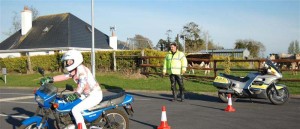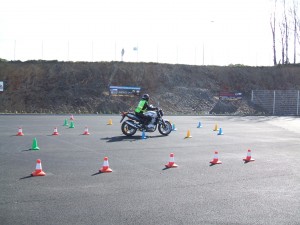All new first time learner permit holders for motorcycles, and anyone upgrading between categories, are required to undertake Initial Basic Training (IBT) with an Approved Driving Instructor (ADI).
IT IS ILLEGAL TO DRIVE ON THE PUBLIC ROAD UNLESS YOU HAVE COMPLETED IBT AND CARRY THE CERTIFICATE ALONG WITH YOUR LEARNER PERMIT (S.I. No. 681/2011)
For a novice rider the entire course is 18 hours spread over 4 modules.
For a rider moving between categories (for example A2 -> A), from automatic to manual or tricycle to two-wheeler, a progression module (Module 5) is available (Details of your previous IBT may be required)
Once this course of lessons is complete the learner permit holder will be issued with a certificate which must be kept with their learner permit.
- Motorcycle riders must complete the program before driving unsupervised on the road while a learner.
- Evidence of completing the lessons will be signed off in a learner’s logbook by the Approved Driving Instructor.
- Evidence of having taken the lessons will have to be presented before taking a driving test.
I.B.T. is done in four modules. The specific detail of these modules is as set out below.
There are two classroom and two practical modules in a complete I.B.T. syllabus. (Please confirm any recent changes with your trainer as the syllabus is subject to ongoing revision)
The IBT motorcycle training modules
Module 1
Module 1 is a classroom based module and has six objectives. You will need at least three hours to achieve them. They cover:
- Personal protective equipment (PPE)
- Introduction to motorcycle controls
- Technical checks
- Placing motorcycle on and off the stand
- Walking alongside the motorcycle
- How to start and stop the engine
Module 2

Courtesy of Tony Moore – motorcycletraining.ie
Module 2 is done in the training area and has 10 objectives. You will need at least five hours to achieve them. They cover:
- Moving off and stopping
- Use of brakes
- Use of gears
- Slow riding
- Figure of eight
- U-turn
- Slalom
- Rear observation and mirrors
- Turning left and right
- Emergency adjustment of speed
Module 3
Module 3 is classroom based and has nine objectives. You will need at least two hours to achieve them. They cover:
- Legal requirements
- Rules of the road
- Being seen
- Road surfaces
- Road and lane position
- Rear observations and mirrors
- Speed
- Anticipation and reaction
- Weather conditions
Module 4
Module 4 is road based and has eight objectives. You will need at least six hours to achieve them. They cover:
- Gradients
- Junctions
- Traffic lights
- Roundabouts
- Safe distance
- Anticipation and reaction
- Pedestrian crossings
- Bends
During this module your trainer will be in radio link with you from his/her own motorcycle on a public road. They will supply the radios. Please note: You may have to supply your own PPE for any or all of the training – please check with your trainer.
Module 5 (Progression Module)
Module 5 is a practical module (training area and public road) and includes topics previously covered during Modules 2 & 4 with some additional new content to allow ‘progression’ the training needs to be undertaken on the new vehicle type, you wish to change to, e.g. from ‘automatic’ to ‘manual’.
This Module facilitates changes in your entitlements without your having to repeat the entire training course.

Courtesy of Richard Thompson – Roadskill.ie
- Moving off and stopping
- Use of brakes
- Use of gears
- Slow riding exercise
- Figure of eight exercise
- U-turn exercise
- Slalom exercise
- Rear observation and mirror work
- Turning left and right
- Obstacle Avoidance
- Emergency adjustment of speed
- Overtaking
- Carrying pillion Passengers
- Using a Sidecar / towing a Trailer
- Gradients
- Junctions
- Traffic lights
- Roundabouts
- Safe distance
- Anticipation and reaction to hazards including dealing with Emergency service vehicles.
- Pedestrian & rail crossings (rail where possible)
- Bends
- Socially responsible Riding/driving
Module 5 may also allow riders to progress up a category (A1 to A2, or A2 to A) with no further test requirement. Additional time may be required for this purpose.